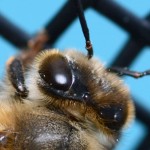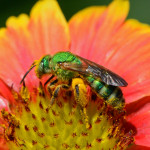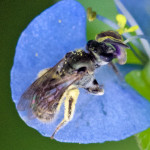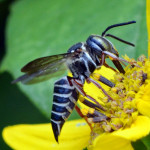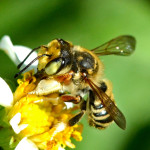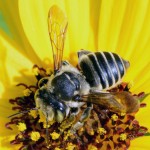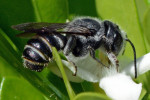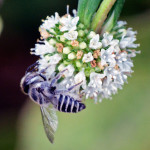Earlier in September I discovered yet another kind of bee on my property: a leaf-cutter bee in the genus Megachile, this one has huge furry white legs and an amazing two-tone eye. Its “common name” is basically just a translation of its taxonomic name: Megachile albitarsis, the white-footed leaf-cutter bee:
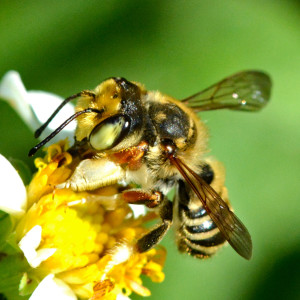
Like most of the other bees I’ve found in the area, this one was cruising from flower to flower exploring the Spanish Needles for nectar and pollen:
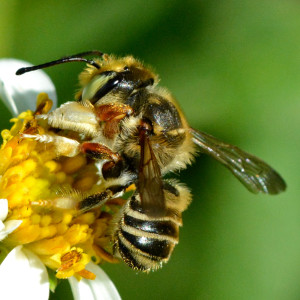
And just recently, I captured an image of a teeny tiny bee that had enough detail in it to enable John Ascher, the bee guru at Bug Guide, to offer an identification: Lasioglossum lepidii, a halictid. I have the signal honor of being the first contributor with an image of this species in bugguide.net:
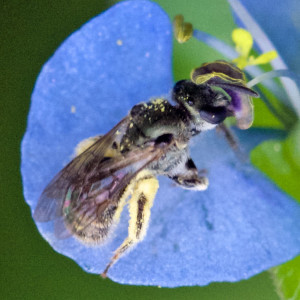
In the guide for the subgenus to which this bee species belongs (Dialictus), the following rather desperate note is offered:
Extremely difficult to ID to species, even under the microscope. They are so morphologically monotonous that breaking them into species groups isn’t really an option. Many species can only be IDed by the relative density of punctures on the surface of the bee.However: “The limiting factor is resolution of the images. If we could clearly see antennal proportions and scutual sculpturing many species identifications would become possible.” (Comment by John Ascher).
I’m glad my two images were enough for him to give an ID of this guy this time around. (An earlier attempt from last October did not provide enough detail for a positive ID. The new 200-mm macro might have made the difference. Or the fact that I used a tripod this time.)
Now that I’m up to 7 or 8 species for the yard, it’s time to start listing them all so I can keep track of them; the ubiquitous Apis mellifera, the European Honeybee, is of course a daily visitor as well.
- Agapostemon splendens, a halictid bee.
- Coelioxys dolichos, a cuckoo-bee in the megachilinae.
- Halictus poeyi, a halictid.
- Lasioglossum sp., a (very small) unidentified halictid. Presumably L. lepidus (see next list item).
- Lasioglossum lepidii, very small (and first picture in Bug Guide!) halictid.
- Megachile petulans, a megachilid.
- Megachile sp. Subgenus Chelostomoides, one of several hard-to-differentiate species.
- An unidentified megachilid, perhaps “just another” M. petulans.
- Megachile albitarsis.
So. There you have it. To my surprise, only three (or perhaps four) “sweat bees” (halictids) and four (or perhaps five) leaf-cutter bees (megachilids), in addition to the ubiquitous honeybee
For those who are curious, here’s a little gallery of all the bees I’ve seen:

